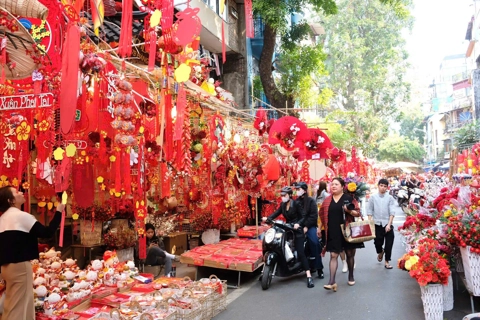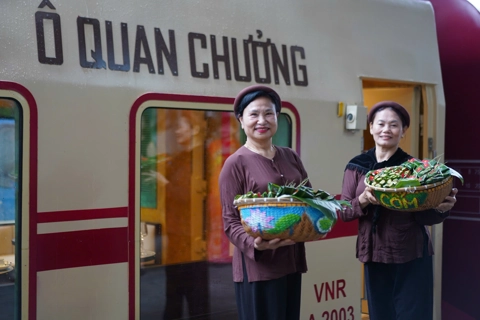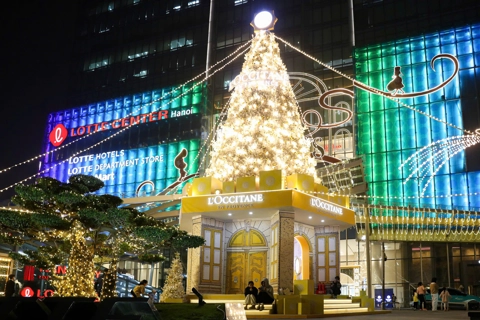Life
Vietnam and 12 UNESCO Intangible Cultural Heritage elements
Dec 10, 2017 / 02:54 PM
Vietnam has to date owned ten elements inscribed on the UNESCO-recognized list of Intangible Cultural Heritage and two others listed as heritages in need of urgent safeguarding.
Nha nhac, Vietnamese Court Music - An Intangible Cultural Heritage
On November 7, 2003, UNESCO bestowed world heritage status on 28 relics of nations as masterpieces of oral and intangible heritage of humanity. Among the 11 masterpieces of Asia, nha nhac (royal music) represents the first intangible legacy of Vietnam to have been put on this list.
The UNESCO Council appraised Vietnamese royal music in the following terms: “Vietnamese royal music represents an elegant and refined music. It deals with the music performed in the imperial courts and on different anniversaries, religious festivals, and on such particular occasions. Of the different categories developed in Vietnam, only the royal music was national.”
Nha nhac (Vietnamese royal music) and its principles came to Vietnam under the Ho Dynasty (1400 - 1407). The Ho Dynasty, however, only existed for a short time, so nha nhac rapidly fell into oblivion. In 1427, Le Loi defeated the Chinese Ming invaders and liberated the country. However,nha nhac only began to develop in the reign of King Le Thanh Tong (1460 - 1497) and reached its peak under the Nguyen Dynasty (1802 - 1945).
Nha nhac is genre of scholarly music. It attracted the participation of many talented songwriters and musicians, with numerous traditional musical instruments. From now on, nha nhac will have opportunities to preserve, develop and popularize to the public, inside and outside the country.
Space of Gong Culture
Specific values of the cultural space of the Central Highlands gong which is a part of Vietnam's cultural heritage and quintessence has been recognised by the international community.
On 25th November 2005, the UNESCO decided to recognize “The cultural space of gong in the Central Highlands” of Vietnam as “Masterpieces of the Oral and Intangible Cultural Heritage of Humanity”.
Throughout the Central Highlands of Viet Nam, Gong ensembles are parts of various ceremonies and closely linked to the communities’ daily life and the cycle of the seasons. The instruments, measuring 25 to 80 centimetres, are played by men as well as women.
The culture space of the Gongs of central Vietnam is about original musical forms, which are performed against the background of the linguistic and ethnic diversity of the region. Diversity is also found in the compositions and customs of the Gong ensembles, in their performance techniques, in the musical genres and in the ritual functions of the gongs.
In the realm of Vietnam’s musical instruments, the gongs are very well-known for their outstanding value and regarded as the privileged language bridging humanity and the supernatural world. The gongs are made from a mixture of bronze and silver, with some distinctive features. The peoples living in the Central Highlands of Viet Nam possess many sets of gongs, which would be performed differently. A set of gongs consists of two to twenty units.
Quan ho Bac Ninh folk song
The UNESCO recognized Quan ho Bac Ninh folk songs as the Intangible Cultural Heritage of Humanity on September 30, 2009. Quan ho is a romantic folk performing art, which is rooted in Kinh Bac area (present Bac Ninh province). There are 49 Quan ho villages in Bac Ninh province and each village has one or more Quan ho man or woman Quan ho groups.
There are 5 to 6 performers who sing well in a group of Quan ho. Leading in each group by chi ca (first sister)or anh ca (first brother). Then, chi hai (second sister)of (second brother)etc. It depends on man or woman groups.
Ca Tru singing
Ca Tru is inscribed on the list of Intangible Cultural Heritage in need of Urgent Safeguarding in 2009. Ca trù also known as hát ả đào or hát nói, is an ancient genre of chamber music featuring female vocalists, with origins in northern Vietnam.
For much of its history, it was associated with a geisha-like form of entertainment, which combined entertaining wealthy people as well as performing religious songs for the royal court.
Giong Festival of Phu Dong and Soc temple
The Saint Giong Festival at the Phu Dong and Soc temples were officially recognized as an Intangible Cultural Heritage of Humanity on November 16, 2010, at the fifth session of the UNESCO Intergovernmental Committee for Safeguarding Intangible Cultural Heritage in Nairobi, Kenya.
The Giong Festival is a traditional festival in commemoration and praise of the mythical hero Saint Giong, one of four immortals of Vietnamese folk beliefs. The festival vividly imitates the evolution of fights of Saint Giong and Van Lang people under the 6th King Hung reign in combating against the foreign enemies, thereby raising the public awareness about the forms of ancient tribe war and educating the patriotism, martial art traditions, indomitable will, and independence and freedom desire of the nation. The Giong Festival is held in many locations throughout the northern part of Viet Nam, however the most typical ones are the Giong Festival at Phu Dong and Soc temples (Hanoi).
Worship of Hung Kings in Phu Tho
The unique practice of worshipping Hung Kings in Phu Tho province, Vietnam has been recognized by UNESCO as part of the world’s intangible cultural heritage on 2012.
The worship of Hung Kings originates thousands of years ago in the era of Hung Kings Dynasty in the belief that all Vietnamese people have the same origin "Dragon's children and Fairy's grand-children"; and also expresses Vietnamese philosophy "When drinking water, re-member its source" creating power for building national unity in Vietnam.
Don Ca Tai Tu music
Vietnam’s “Don ca tai tu” (southern folk music) on 2013 December 5 made UNESCO’s Representative List of Intangible Cultural Heritage of Humanity. “Don ca Tai Tu,” considered one of the country’s main chamber music genres, originated from Hue court music and folk music of the southern region. The genre has been developing since the 19th century, changing with local taste. It thrived in the early 20th century and remains crucial to the country’s traditional culture.
Vi and Giam folk songs of Nghe Tinh
On 27 November 2014, in the 9th session of Intergovernmental Committee for the Safeguarding of the Intangible Cultural Heritage of UNESCO in Paris (France), Vi and Giam folk songs of Nghe Tinh was officially recognized as Intangible Cultural Heritage of Humanity.
Vi and Giam folk songs of Nghe Tinh occupy an important position in the cultural and spiritual life of people of Nghe An and Ha Tinh provinces (abbreviated as Nghe Tinh). This is a type of art that has long lasting life, imbued character and manner of Nghe Tinh people and is the precious heritage in Vietnamese cultural treasure.
Tugging rituals and games
On 2 December 2015, at the 10th session of the Intergovernmental Committee for Safeguarding of the Intangible Cultural Heritage of UNESCO held in Windhoek City, the Republic of Namibia, Tugging rituals and games in Cambodia, South Korea, the Philippines, and Vietnam have been officially recognized as Intangible Cultural Heritage of Humanity.
Tugging is a social ritual with the purpose of wishing for rainfall required for agriculture and bountiful harvests or fortune-telling with regards to the success or failure of farming efforts. It is believed that practicing and obeying the rules of tugging ritual will help abundant harvests, prosperity, and happiness. So, not only as a common folk game, tugging also contains deep culture values expressing through own customs and beliefs of each country.
Vietnamese belief in Mother Goddesses
The Practices related to the Vietnamese belief in Mother Goddesses of the three Realms has been officially recognized by UNESCO as an intangible cultural heritage of humanity.
This was announced at the 11th Conference of the Inter-Governmental Committee for the Safeguarding of Intangible Cultural Heritage, which is taking place at Addis Ababa, Ethiopia from 2016 November 28 to December 3.
Mother Goddess worship is a traditional practice in Vietnam with a long history, having stood the test of social changes. The belief in Mother Goddess worship reflects people’s desire for health, wealth and fortune.
The practice rituals meet belief-related needs by people in their daily life and has been closely associated with historical and cultural figures, such as Lieu Hanh, Au Co, Vuong Mau (legendary Mother of Saint Giong).
Xoan singing
Xoan singing from the northern province of Phu Tho has been added to the United Nations Educational, Scientific and Cultural Organisation’s (UNESCO) list of intangible cultural heritage of humanity on 2017.
The decision was announced on Friday during UNESCO’s 12th session of the Intergovernmental Committee for Safeguarding Intangible Cultural Heritage, held on South Korea’s Jeju Island. In 2011, xoan singing had been listed as cultural heritage in need of urgent safeguarding.
Xoan singing is practised in Phu Tho Province, often during the first two months of the lunar year. Traditionally, singers perform songs in sacred spaces such as temples, shrines and communal houses for the spring festivals.
There are three forms of xoan singing: worship singing for the Hung kings and village guardian spirits; ritual singing for good crops, health and luck, and festival singing where villagers alternate male and female voices in a form of courtship.
Bai Choi singing
"Bai Choi" singing, has been added to the UNESCO Representative List of the Intangible Cultural Heritage of Humanity. The decision was announced on 2017 November 7 during the 12th session of the UNESCO Intergovernmental Committee for the Safeguarding of the Intangible Cultural Heritage, which is being held in Jeju, South Korea.
Bai Choi singing is popular in Quang Binh, Quang Tri, Thua Thien-Hue, Quang Nam, Binh Dinh, Phu Yen, Khanh Hoa and Da Nang. Bai Choi is often seen at local spring festivals and resembles a game, using playing cards and village huts. The Bai Choi songs are about festivals, daily life and work and are accompanied by musical instruments.

Nha nhac, Vietnamese Court Music.
|
The UNESCO Council appraised Vietnamese royal music in the following terms: “Vietnamese royal music represents an elegant and refined music. It deals with the music performed in the imperial courts and on different anniversaries, religious festivals, and on such particular occasions. Of the different categories developed in Vietnam, only the royal music was national.”
Nha nhac (Vietnamese royal music) and its principles came to Vietnam under the Ho Dynasty (1400 - 1407). The Ho Dynasty, however, only existed for a short time, so nha nhac rapidly fell into oblivion. In 1427, Le Loi defeated the Chinese Ming invaders and liberated the country. However,nha nhac only began to develop in the reign of King Le Thanh Tong (1460 - 1497) and reached its peak under the Nguyen Dynasty (1802 - 1945).
Nha nhac is genre of scholarly music. It attracted the participation of many talented songwriters and musicians, with numerous traditional musical instruments. From now on, nha nhac will have opportunities to preserve, develop and popularize to the public, inside and outside the country.
Space of Gong Culture

Space of Gong Culture.
|
On 25th November 2005, the UNESCO decided to recognize “The cultural space of gong in the Central Highlands” of Vietnam as “Masterpieces of the Oral and Intangible Cultural Heritage of Humanity”.
Throughout the Central Highlands of Viet Nam, Gong ensembles are parts of various ceremonies and closely linked to the communities’ daily life and the cycle of the seasons. The instruments, measuring 25 to 80 centimetres, are played by men as well as women.
The culture space of the Gongs of central Vietnam is about original musical forms, which are performed against the background of the linguistic and ethnic diversity of the region. Diversity is also found in the compositions and customs of the Gong ensembles, in their performance techniques, in the musical genres and in the ritual functions of the gongs.
In the realm of Vietnam’s musical instruments, the gongs are very well-known for their outstanding value and regarded as the privileged language bridging humanity and the supernatural world. The gongs are made from a mixture of bronze and silver, with some distinctive features. The peoples living in the Central Highlands of Viet Nam possess many sets of gongs, which would be performed differently. A set of gongs consists of two to twenty units.
Quan ho Bac Ninh folk song

Quan ho Bac Ninh folk song.
|
There are 5 to 6 performers who sing well in a group of Quan ho. Leading in each group by chi ca (first sister)or anh ca (first brother). Then, chi hai (second sister)of (second brother)etc. It depends on man or woman groups.
Ca Tru singing

Ca Tru singing.
|
For much of its history, it was associated with a geisha-like form of entertainment, which combined entertaining wealthy people as well as performing religious songs for the royal court.
Giong Festival of Phu Dong and Soc temple

Giong Festival of Phu Dong and Soc temple.
|
The Giong Festival is a traditional festival in commemoration and praise of the mythical hero Saint Giong, one of four immortals of Vietnamese folk beliefs. The festival vividly imitates the evolution of fights of Saint Giong and Van Lang people under the 6th King Hung reign in combating against the foreign enemies, thereby raising the public awareness about the forms of ancient tribe war and educating the patriotism, martial art traditions, indomitable will, and independence and freedom desire of the nation. The Giong Festival is held in many locations throughout the northern part of Viet Nam, however the most typical ones are the Giong Festival at Phu Dong and Soc temples (Hanoi).
Worship of Hung Kings in Phu Tho

Worship of Hung Kings in Phu Tho.
|
The worship of Hung Kings originates thousands of years ago in the era of Hung Kings Dynasty in the belief that all Vietnamese people have the same origin "Dragon's children and Fairy's grand-children"; and also expresses Vietnamese philosophy "When drinking water, re-member its source" creating power for building national unity in Vietnam.
Don Ca Tai Tu music

Don Ca Tai Tu music.
|
Vi and Giam folk songs of Nghe Tinh

Vi and Giam folk songs of Nghe Tinh.
|
Vi and Giam folk songs of Nghe Tinh occupy an important position in the cultural and spiritual life of people of Nghe An and Ha Tinh provinces (abbreviated as Nghe Tinh). This is a type of art that has long lasting life, imbued character and manner of Nghe Tinh people and is the precious heritage in Vietnamese cultural treasure.
Tugging rituals and games

Tugging rituals and games.
|
Tugging is a social ritual with the purpose of wishing for rainfall required for agriculture and bountiful harvests or fortune-telling with regards to the success or failure of farming efforts. It is believed that practicing and obeying the rules of tugging ritual will help abundant harvests, prosperity, and happiness. So, not only as a common folk game, tugging also contains deep culture values expressing through own customs and beliefs of each country.
Vietnamese belief in Mother Goddesses

Vietnamese belief in Mother Goddesses.
|
This was announced at the 11th Conference of the Inter-Governmental Committee for the Safeguarding of Intangible Cultural Heritage, which is taking place at Addis Ababa, Ethiopia from 2016 November 28 to December 3.
Mother Goddess worship is a traditional practice in Vietnam with a long history, having stood the test of social changes. The belief in Mother Goddess worship reflects people’s desire for health, wealth and fortune.
The practice rituals meet belief-related needs by people in their daily life and has been closely associated with historical and cultural figures, such as Lieu Hanh, Au Co, Vuong Mau (legendary Mother of Saint Giong).
Xoan singing

Xoan singing.
|
The decision was announced on Friday during UNESCO’s 12th session of the Intergovernmental Committee for Safeguarding Intangible Cultural Heritage, held on South Korea’s Jeju Island. In 2011, xoan singing had been listed as cultural heritage in need of urgent safeguarding.
Xoan singing is practised in Phu Tho Province, often during the first two months of the lunar year. Traditionally, singers perform songs in sacred spaces such as temples, shrines and communal houses for the spring festivals.
There are three forms of xoan singing: worship singing for the Hung kings and village guardian spirits; ritual singing for good crops, health and luck, and festival singing where villagers alternate male and female voices in a form of courtship.
Bai Choi singing

Bai Choi singing.
|
Bai Choi singing is popular in Quang Binh, Quang Tri, Thua Thien-Hue, Quang Nam, Binh Dinh, Phu Yen, Khanh Hoa and Da Nang. Bai Choi is often seen at local spring festivals and resembles a game, using playing cards and village huts. The Bai Choi songs are about festivals, daily life and work and are accompanied by musical instruments.








